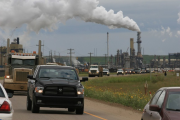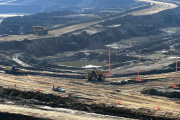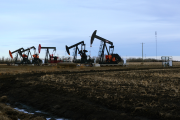One short decade ago, the oilsands were scarcely known of outside of Alberta. Apart from energy analysts and oil patch insiders, few Canadians — let alone the rest of the world — had ever heard of them.
That seems impossible to imagine today.
The oilsands are known the world over, and typically not in the most positive light. As production climbed dramatically over the past decade, the industry’s environmental footprint grew too. To take just one example, climate-changing greenhouse gas emissions from the sector have doubled. So has the oilsands’ share of Canada’s total emissions. The sector now emits more greenhouse gas pollution than all of Atlantic Canada put together.
So how will things look in northeastern Alberta a decade from now? The Pembina Institute set out to answer that question in a report titled Forecasting the impacts of oilsands expansion. With oilsands production set to double again in the next 10 years, today’s footprint is only a partial picture of the growing environmental concerns associated with oilsands development. It’s critical to understand not just where we are, but also where we’re headed, because the decisions we make today are setting that course.
The Government of Alberta expects oilsands output to grow rapidly over the next decade as new projects are developed and existing ones are expanded. A growing share of production will come from in situdevelopment — drilling techniques used to access resources that are too deep to mine from the surface. But that doesn’t mean mining will slow down. The output from mining projects is expected to increase by more than 70 per cent over the next 10 years.
To get a sense of the industry’s impact 10 years from now, we can apply the impacts associated with producing each barrel of bitumen to a forecast of future production volumes. The picture that emerges is not a rosy one. Mining and in situ development impose distinct environmental impacts. But with both types of production expanding, the total environmental footprint of oilsands development will expand significantly, challenging efforts to manage it responsibly.
Oilsands projects already use as much water as nearly two million Canadians. Over the next decade, their water consumption is expected to double. By 2022, oilsands projects are projected to be consuming the equivalent of 309 Olympic-sized swimming pools of fresh water every day, much of it from the Athabasca River.
The industry has made some improvements in reducing the amount of air pollution per barrel of oil produced. However, the rapid growth in oilsands production means that the total amount of pollution is still rising.
That trend will continue. Ten years from now, the emissions of air pollutants that contribute to smog, acid rain and lung disease are projected to increase by between 75 and 100 per cent, significantly eroding air quality in the north of the province.
Tailings lakes — where toxic byproducts from bitumen extraction are stored — already cover 176 square kilometres of Alberta’s landscape. The expansion of mining means plenty more to come. In a decade, oilsands mining projects will produce enough tailings to fill the wave pool at West Edmonton Mall — the world’s largest — 31 times each day.
The list of projected impacts goes on, from clearing 34.5 football fields of forest per day to emitting as much greenhouse gas pollution as 22 million cars.
And that’s just the next decade. Oilsands expansion will continue well beyond then. The government has already approved enough projects to grow production another 40 per cent beyond the levels I’ve described, and the industry has plans to expand much further. This massive growth in bitumen production will trump even the best intentions of the most progressive oil companies. The modest incremental gains achieved by individual companies or new technologies will likely be overwhelmed by the sheer growth in production.
Are Albertans really willing to accept impacts on this scale? Without the laws and enforcement in place to moderate development, drive real improvements and set limits on impacts, the government’s claim of “responsible resource development” is just a catchphrase. The consequences will be serious for our land, water and atmosphere. The implications for our international reputation and access to markets — as we’ve already seen with opposition to the Keystone XL pipeline — will be just as severe.
If we don’t take the time to get these policies right, a decade from now Albertans will look back fondly on 2013 as the time when hardly anyone complained about the oilsands.
P.J. Partington is a technical and policy analyst at the Pembina Institute. Download: Forecasting the impacts of oilsands expansion.




